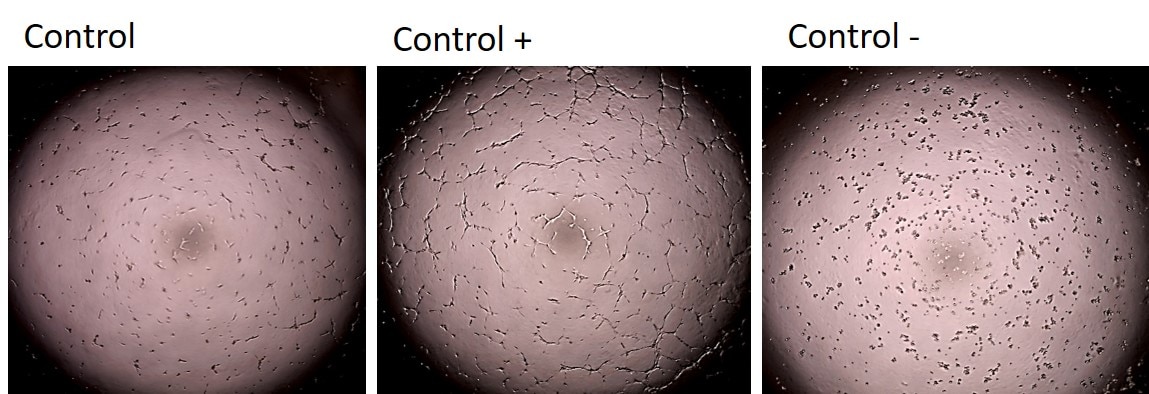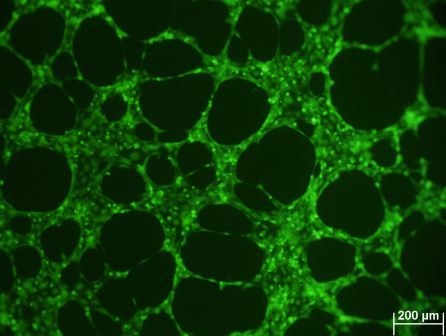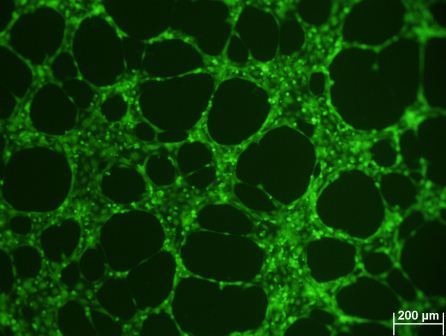Cultrex In Vitro Angiogenesis Assay (Tube Formation)
Cultrex In Vitro Angiogenesis Assay (Tube Formation) Summary
Allows for the detection of inducers and inhibitors of endothelial cell tube formation.Why Use Cultrex In Vitro Angiogenesis Assay (Tube Formation), 96-well?
The Cultrex in vitro Angiogenesis Assay Tube Formation Kit was developed for the evaluation of inducers and inhibitors of endothelial cell tube formation. During the course of the assay, endothelial cells are seeded on a thick gel of Basement Membrane Extract in the presence of angiogenesis modulating agents. If the medium is permissive to the angiogenic response, cells will self assemble into tube networks within hours; if there are inhibitors in the medium, tube network formation will be incomplete or nonexistent. Sulforaphane [1- isothiocyanato-(4R)- methylsulfinyl)-butane], found in broccoli and other cruciferous vegetables, is a naturally occurring cancer chemopreventive agent, and is provided as a control inhibitor to visualize this process. Endothelial cells may be fluorescently labeled using Calcein AM, and images captured using a microscope camera may be analyze to quantify the angiogenic response. Cultrex in vitro Angiogenesis Assay Kit provides a cost-effective method for investigation of prospective angiogenesis inhibitors in a 96 well plate format.
Kit Contents
• Cell Staining Solution
• Cultrex BME, reduced growth factor without phenol red
• Sulforaphane
• Calcein AM
Note: The components for this kit may require different storage/shipping temperatures and may arrive in separate packaging.
Specifications
Limitations
For research use only. Not for diagnostic use.
Product Datasheets
Citations for Cultrex In Vitro Angiogenesis Assay (Tube Formation)
R&D Systems personnel manually curate a database that contains references using R&D Systems products. The data collected includes not only links to publications in PubMed, but also provides information about sample types, species, and experimental conditions.
15
Citations: Showing 1 - 10
Filter your results:
Filter by:
-
Restoration of angiogenic capacity in senescent endothelial cells by a pharmacological reprogramming approach
Authors: Kalies, K;Knöpp, K;Koch, S;Pilowski, C;Wurmbrand, L;Sedding, D;
PloS one 2025-02-28
-
Novel Small Molecules with Anti-Inflammatory and Anti-Angiogenic Activity in a Mouse Model of Oxygen-Induced Retinopathy
Authors: Dayoub, AS;Acharya, E;Dibas, A;Jones, HP;Acharya, S;
Cells 2024-08-17
-
Multi-Omics Analysis of Circulating Exosomes in Adherent Long-Term Treated OSA Patients
Authors: Khalyfa, A;Marin, JM;Sanz-Rubio, D;Lyu, Z;Joshi, T;Gozal, D;
International journal of molecular sciences 2023-11-08
-
EDIL3 as an angiogenic target of immune exclusion following checkpoint blockade
Authors: Tabasum, S;Thapa, D;Giobbie-Hurder, A;Weirather, JL;Campisi, M;Schol, PJ;Li, X;Li, J;Yoon, CH;Manos, MP;Barbie, DA;Hodi, FS;
Cancer immunology research 2023-09-20
-
Exosomes from chondrocytes overexpressing miR-214-3p facilitate M2 macrophage polarization and angiogenesis to relieve Legg Calv�-Perthes disease
Authors: Lan, X;Yu, R;Xu, J;Jiang, X;
Cytokine 2023-05-27
-
Galectin-1 and -3 in high amounts inhibit angiogenic properties of human retinal microvascular endothelial cells in vitro
Authors: A Hillenmaye, CM Wertheimer, A Geerlof, KH Eibl, S Priglinger, C Priglinger, A Ohlmann
PLoS ONE, 2022-03-23;17(3):e0265805. 2022-03-23
-
Effect of Atmospheric Aging on Soot Particle Toxicity in Lung Cell Models at the Air-Liquid Interface: Differential Toxicological Impacts of Biogenic and Anthropogenic Secondary Organic Aerosols (SOAs)
Authors: S Offer, E Hartner, S Di Bucchia, C Bisig, S Bauer, J Pantzke, EJ Zimmermann, X Cao, S Binder, E Kuhn, A Huber, S Jeong, U Käfer, P Martens, A Mesceriako, J Bendl, R Brejcha, A Buchholz, D Gat, T Hohaus, N Rastak, G Jakobi, M Kalberer, T Kanashova, Y Hu, C Ogris, A Marsico, F Theis, M Pardo, T Gröger, S Oeder, J Orasche, A Paul, T Ziehm, ZH Zhang, T Adam, O Sippula, M Sklorz, J Schnelle-K, H Czech, A Kiendler-S, Y Rudich, R Zimmermann
Environmental health perspectives, 2022-02-03;130(2):27003. 2022-02-03
-
Tumour exosomal CEMIP protein promotes cancer cell colonization in brain metastasis
Authors: G Rodrigues, A Hoshino, CM Kenific, IR Matei, L Steiner, D Freitas, HS Kim, PR Oxley, I Scandariat, I Casanova-S, J Dai, CR Badwe, B Gril, M Teši? Mark, BD Dill, H Molina, H Zhang, A Benito-Mar, L Bojmar, Y Ararso, K Offer, Q LaPlant, W Buehring, H Wang, X Jiang, TM Lu, Y Liu, JK Sabari, SJ Shin, N Narula, PS Ginter, VK Rajasekhar, JH Healey, E Meylan, B Costa-Silv, SE Wang, S Rafii, NK Altorki, CM Rudin, DR Jones, PS Steeg, H Peinado, CM Ghajar, J Bromberg, M de Sousa, D Pisapia, D Lyden
Nat. Cell Biol., 2019-11-04;21(11):1403-1412. 2019-11-04
-
The role of NUDT21 in microRNA-binging sites of EZH2 gene increases the of risk preeclampsia
Authors: X Lang, W Zhao, D Huang, W Liu, H Shen, L Xu, S Xu, Y Huang, W Cheng
J. Cell. Mol. Med., 2019-03-18;0(0):. 2019-03-18
-
Isoliquiritin Apioside Suppresses in vitro Invasiveness and Angiogenesis of Cancer Cells and Endothelial Cells
Authors: A Kim, JY Ma
Front Pharmacol, 2018-12-10;9(0):1455. 2018-12-10
-
Interleukin-33 modulates inflammation in endometriosis
Authors: JE Miller, SP Monsanto, SH Ahn, K Khalaj, AT Fazleabas, SL Young, BA Lessey, M Koti, C Tayade
Sci Rep, 2017-12-20;7(1):17903. 2017-12-20
-
Gastric tumour-derived ANGPT2 regulation by DARPP-32 promotes angiogenesis.
Authors: Chen Z, Zhu S, Hong J, Soutto M, Peng D, Belkhiri A, Xu Z, El-Rifai W
Gut, 2015-03-16;65(6):925-34. 2015-03-16
-
Syndecan-4 is a major syndecan in primary human endothelial cells in vitro, modulated by inflammatory stimuli and involved in wound healing.
Authors: Vuong T, Reine T, Sudworth A, Jenssen T, Kolset S
J Histochem Cytochem, 2015-01-09;63(4):280-92. 2015-01-09
-
Inhibiting NF-kappaB in the developing lung disrupts angiogenesis and alveolarization.
Authors: Iosef C, Alastalo T, Hou Y, Chen C, Adams E, Lyu S, Cornfield D, Alvira C
Am J Physiol Lung Cell Mol Physiol, 2012-02-24;302(10):L1023-36. 2012-02-24
-
Tumor cell-derived angiopoietin-like protein ANGPTL2 is a critical driver of metastasis.
Authors: Endo M, Nakano M, Kadomatsu T, Fukuhara S, Kuroda H, Mikami S, Hato T, Aoi J, Horiguchi H, Miyata K, Odagiri H, Masuda T, Harada M, Horio H, Hishima T, Nomori H, Ito T, Yamamoto Y, Minami T, Okada S, Takahashi T, Mochizuki N, Iwase H, Oike Y
Cancer Res, 2012-02-16;72(7):1784-94. 2012-02-16
FAQs
-
What is the Tube Formation Assay?
The Tube Formation Assay is based on the ability of endothelial cells to form three-dimensional capillary-like tubular structures when cultured on a hydrogel of reconstituted basement membrane, such as Cultrex Basement Membrane Extract (BME).
-
What are the advantages of the Tube Formation Assay?
The Tube Formation Assay is the most widely used in vitro angiogenesis assay. The assay is rapid, inexpensive and quantifiable. It can be used to identify potentially angiogenic and anti-angiogenic factors, to determine endothelial cell phenotype, and to study pathways and mechanisms involved in angiogenesis. It can be performed in a high throughput mode to screen for a large number of compounds.
-
What cell types can be used in the Tube Formation Assay?
The Tube Formation Assay is specific for endothelial cells, either primary cells or immortalized cell lines. Only endothelial cells form capillary-like structures with a lumen inside. Other endothelial cell types form other structures.
-
What are the variables associated with the Tube Formation Assay?
The major variables associated with tube formation are composition of the Cultrex Basement Membrane Extract (BME) hydrogel, thickness of the hydrogel, cell density, composition of angiogenic factors in the assay medium, and assay period.
-
Which Cultrex Basement Membrane Extract (BME) should I use for the Tube Formation Assay?
Cultrex Reduced Growth Factor BME (RGF BME) is generally used for testing compounds that promote angiogenesis because formation of capillary-like structures (tubes) is significantly less compared to non-growth factor reduced varieties of Cultrex BME. The Cultrex In Vitro Angiogeneis Assay (Tube Formation) includes a qualified production lot of Cultrex RGF BME that exhibits reduced background tube formation in the absence of angiogenic factors.
-
How do I reduce spontaneous formation of tubular structures on Cultrex BME in the absence of angiogenic factors?
Primary endothelial cells, such as Human Umbilical Vein Endothelial Cells (HUVECs) form capillary-like structures in the absence of added angiogenic factors less often than immortalized endothelial cells. Generally, reducing the number of cells per cm2 plated onto Cultrex BME will result in less background or spontaneous tube formation. Titrate the number of cells and find optimal conditions for your specific cell line. When endothelial cells fully form capillary structures in response to angiogenic activators, but not in their absence, you may proceed.
Reviews for Cultrex In Vitro Angiogenesis Assay (Tube Formation)
Average Rating: 4.8 (Based on 4 Reviews)
Have you used Cultrex In Vitro Angiogenesis Assay (Tube Formation)?
Submit a review and receive an Amazon gift card.
$25/€18/£15/$25CAN/¥75 Yuan/¥2500 Yen for a review with an image
$10/€7/£6/$10 CAD/¥70 Yuan/¥1110 Yen for a review without an image
Filter by:




